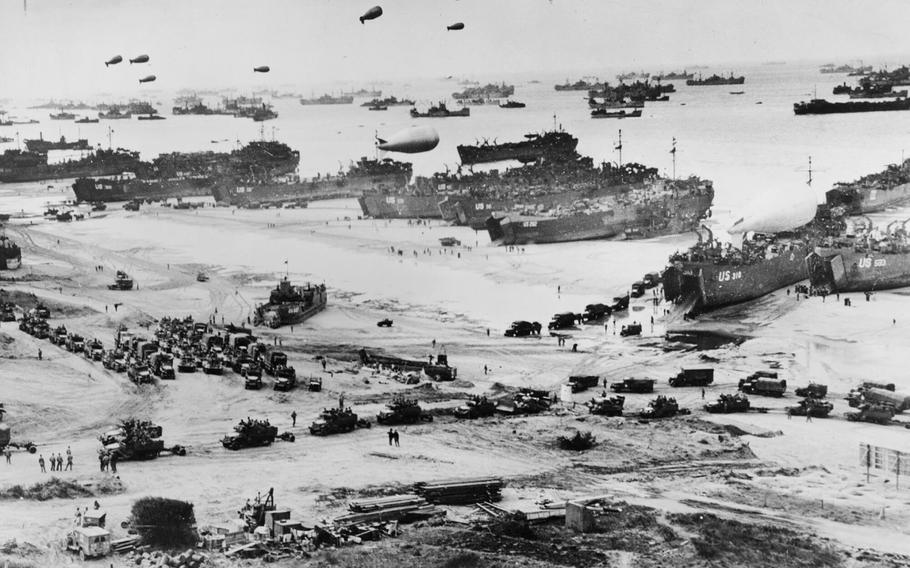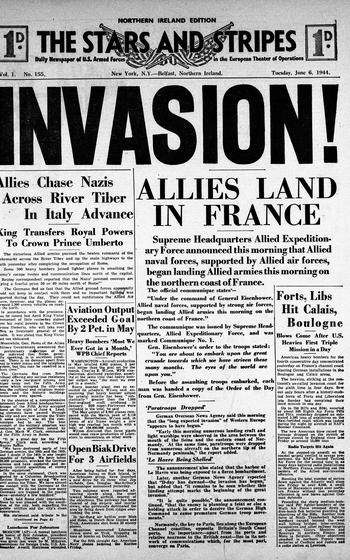
A bird’s-eye view of Allied troops landing in Normandy, France, on D-Day, June 6, 1944. (National Archives)
It was a day that defined the world for generations.
On June 6, 1944, about 160,000 American, British and Canadian troops stormed five beaches along a 60-mile front in Normandy in the largest seaborne invasion in history. They seized a foothold in northern France and paved the way for the defeat of Nazi Germany less than a year later.
Thousands died in the first 24 hours, although the precise number of casualties remains in doubt. Tens of thousands more died before the Germans were swept from Normandy nearly three months later.
The world still lives in the shadow of D-Day, which molded history for generations to come.
Had the landings failed, Soviet dictator Josef Stalin might have considered a separate peace with Adolf Hitler, as Russia had done in 1917 during World War I. If the Soviets remained in the war, they would likely have seized even more territory, expanding Communist control of a wider area of postwar Europe.
Even if the United States had rebounded, the shock of defeat on the Normandy beaches could have cost Franklin D. Roosevelt the White House in the November 1944 election. Harry S. Truman and Dwight D. Eisenhower would have become historical footnotes.
And countless more soldiers, sailors and airmen would have likely died before the global conflict finally ended.
Long before the first Allied paratrooper stepped out the door of his aircraft or the first shells roared from the 1,140 Allied warships offshore, the British and the Americans had been pondering the idea of a massive assault along the French coast to confront the Nazi war machine.

The Northern Ireland edition of Stars and Stripes reports news of the Allied landing. (Stars and Stripes)
In March 1942, only three months after the U.S. had entered the war, Army Chief of Staff Gen. George C. Marshall sent the White House a plan for an invasion across the English Channel into France by April 1943.
For Marshall and Eisenhower, speed was essential. Unless they took the war to the Germans soon, American generals feared that the Soviet Union, bearing the brunt of the ground war, might collapse. That would free hundreds of thousands of German soldiers to face the Western Allies. Roosevelt concurred — if the British agreed.
British Prime Minister Winston Churchill balked. Churchill remained deeply suspicious of amphibious assaults ever since the disastrous Gallipoli landings in World War I. British, Australian and New Zealand forces suffered more than 160,700 casualties before abandoning the Gallipoli operation against the Ottoman Turks.
Churchill argued that American forces were untested in combat and ill-prepared to face the Germans in a head-on assault. He urged that the Allies instead land in North Africa and engage German and Italian forces there. He believed control of the Mediterranean was vital to British interests in the Suez Canal and its territories in India and East Asia.
Marshall and Eisenhower were loath to expend American lives and resources in what they considered a sideshow to defend someone else’s empire.
However, Roosevelt overruled his generals and on July 30, 1942, ordered them to land instead in North Africa. That ruled out any cross-Channel invasion before 1944. Eisenhower complained privately that Roosevelt’s decision was the “blackest day in history.”
Churchill’s views appeared validated a few weeks later by a catastrophic raid on the French fishing port of Dieppe on the Normandy coast.
More than 6,000 Canadian, British and U.S. Army Rangers stormed ashore on Aug. 19, 1942. After less than 10 hours of heavy fighting, nearly 60 percent of the Allied force had been killed, wounded or captured.
Canada suffered nearly 3,500 casualties among its 5,000-man raiding force. The British lost 106 aircraft, one destroyer and 33 landing craft. None of the major Allied objectives had been met when survivors fled back to England.
Dieppe taught the Allies that a major cross-Channel assault would not succeed without a massive air and naval bombardment, better intelligence and the element of surprise. It also convinced Allied planners that they should avoid a frontal assault on a defended port and land instead on rural beaches.
Marshall and Eisenhower went back to the drawing boards and developed a plan — Operation Overlord — to strike the beaches in Normandy in 1944, even as American and Allied troops were still fighting the Germans and their Italian allies in North Africa, Sicily and Italy.
The decisive Soviet victory over the Germans at Stalingrad in late 1942 and early 1943 meant the Western Allies had time to prepare without fearing an imminent Soviet collapse.
Meanwhile, Hitler began his own planning for a showdown in France. In February 1943, he transferred Gen. Erwin Rommel from North Africa, where the Germans faced defeat, to France to prepare German defenses.
Over the next months, Rommel began work on the “Atlantic Wall,” a 2,400-mile network of bunkers, landmines and sea obstacles, aimed at stopping the invasion on the beach. By June 6, 1944, Rommel estimated that less than 20 percent of the fortifications had been completed.
In late 1943, Roosevelt and Churchill met with Stalin in Tehran, Iran. Despite British misgivings, the two Western leaders promised Stalin they would invade across the Channel in the coming year. In return, Stalin promised to launch a simultaneous offensive in Eastern Europe and enter the war against Japan after Germany surrendered.
Eisenhower was named Supreme Allied Commander and planning kicked into high gear. The Americans were to land on the westernmost beaches — code-named Utah and Omaha — while the British and Canadians would storm three other locations — Gold, Juno and Sword.
The 82nd Airborne Division and the 101st Airborne Division would jump behind German lines on the western flank, while British and Canadian airborne units would parachute along the eastern flank.
For months Allied bombers pounded German defenses and rail networks to disrupt communications and prevent the Nazis from sending reinforcements to the battlefield. Adapting from the lessons of the failed Dieppe raid, the Allies built portable docks, known as “Mulberry harbors,” so they could land supplies without having to seize a port.
They also devised a massive disinformation campaign, complete with phony communications networks, double agents and dummy units, to trick the Germans into thinking the main attack would come at Pas-de-Calais, the narrowest point between France and England northeast of the real landing zones.
The date for the invasion was selected to take advantage of moonlight and maximum low tides, which would expose German obstacles just off the beaches. Eisenhower chose June 5, 1944, but heavy rain and winds forced a 24-hour delay.
At midnight on June 5, Royal Air Force bombers began blasting coastal defenses. A couple of hours later, paratroopers began jumping into France. After a ferocious naval bombardment, infantry and armor landed by boat after 6:30 a.m. More than 11,000 Allied aircraft swarmed the skies, preventing the German Luftwaffe from seriously threatening the invasion from the air.
Nevertheless, the landings didn’t go exactly according to plan.
High winds and heavy groundfire wreaked havoc among parachute and glider units, scattering many of them far from the drop zones. Many drowned in flooded wetlands. One unit of the 82nd Airborne, F Company of the 505th Airborne Infantry, landed in the middle of the village of Sainte-Mere-Eglise and was cut to pieces by the Germans.
Sea swells pushed landing craft away from their targets. Soldiers jumped into the surf disoriented and seasick as they faced intense German fire.
German resistance was the fiercest at Omaha, one of the American beaches, and Juno, where the 14,000-strong Canadian force suffered 340 dead, 574 wounded and 47 captured.
At Omaha, units of the 1st Infantry Division and the 29th Infantry Division faced withering fire from a full German division. Intelligence expected them to face only a regiment. Within the first 10 minutes, all the officers and sergeants from one company were killed or wounded. The combat-experienced 16th Infantry Regiment of the 1st Infantry Division was scattered all over the beach as sea swells pushed its landing craft off course.
Within four hours half the first wave at Omaha was dead or wounded. Gen. Omar Bradley, watching from a ship offshore, wrote that he considered evacuating the beach and diverting forces from Utah and the British beaches.
The 16th Infantry commander, Col. George Taylor, found pockets of terrified soldiers holed up where they could find shelter. “Two kinds of people are staying on this beach, the dead and those who are going to die,” he told his soldiers. “Now let’s get the hell out of here.”
Gen. Dwight D. Eisenhower gives the order of the Day. “Full victory — nothing else” to paratroopers in England just before they board their airplanes to participate in the first assault in the invasion of the continent of Europe. The Soldier wearing No. 23 is Wallace Strobel, who began his military career with the Michigan National Guard. The number corresponds to Strobel’s airplane number. (U.S. Army/National Archives)
.jpg/alternates/PORTRAIT_350/030619DDAY75photo_Order_of_the_Day_page4%2074782584.jpg)
Order of the Day written and issued by Gen. Dwight D. Eisenhower to encourage Allied soldiers taking part in the D-Day invasion of June 6, 1944. He began drafting this Order of the Day Much more polished is his printed Order of the Day in February. The order was distributed to the 175,000-member expeditionary force on the eve of the invasion. (The Eisenhower Presidential Library)
As reinforcements poured onto the beach, the two American divisions managed to move forward to the bluffs as German defenders ran low on ammunition. By the end of the day, the 1st Infantry Division had lost about 1,000 killed and wounded. The 29th Division had suffered 743 casualties, including wounded and missing.
The mostly British troops managed to get ashore at Sword but failed to seize the city of Caen as planned. It took weeks of heavy fighting before the city fell. The Americans faced less resistance than expected at Utah — in part because rough seas pushed the landing craft a few miles south of their target where German defenders were fewer.
By the end of the day, the Allies had suffered major casualties and had failed to achieve many objectives, including seizing Caen. By the end of June 6, the Allies had suffered an estimated 10,000 casualties, including more than 4,400 dead.
That figure was roughly the same number of dead the U.S. military would suffer decades later during more than eight years of war in Iraq.
But the Germans had failed to push them off the beaches.
Nearly a year of bloody fighting lay ahead. But the Allied victory in Europe was assured.